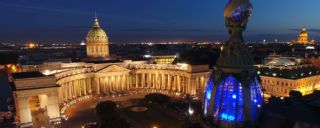 I'm a late entrant to St Petersburg and, with less than two full days here, a fairly brief guest. They say a year isn't enough to see the Hermitage museum, let alone the rest of this grand city, but what little I have seen on a day of tramping around, prompted this question: How on earth did St Petersburg survive 67 years as Leningrad? This is no disrespect to Lenin, whose entry into the Finland Station here in April 1917 was the start of the October Revolution that would end 300 years of Tsarist rule. What I mean is that St Petersburg - the name reverted in 1991 - is such an imperial city, with grandeur, opulence and monarchical statement shouting out from every inch of the boulevards and avenues. Moscow has its share of broad roads and magnificent buildings too but here everything is personalised, to honour the monarch of the day. I guess you could say the Soviet architecture in the Stalinist years was the same but in name, at least, those buildings were dedicated to the people; here the palaces are exclusivist. You don't even need to visit Palace Square to figure that out; all I did was walk down Nevskiy Prospekt, the main avenue that runs through the heart of the city. One of the first buildings I passed was the Kazan Cathedral - I first thought it was yet another grand palace, but read that it was in fact a church designed on St Peter's Basilica in Rome.
Also see: World Cup stories: Jayaditya Gupta in Russia
In fact the statements of the greatest opulence came in small sizes, at the Faberge Museum: Here are housed several of the famous "eggs" created by the French-born jeweler that were Easter gifts from the Tsars to the ladies in their family. Each egg - between three and six inches - is a masterpiece of design and imagination. Each egg opens to reveal at least one additional element. One is a bay-leaf tree, with each tiny leaf an individual piece of jade. Another, made to mark Nicholas II's coronation, opened to reveal an exact replica, around two inches large, of the royal carriage - so precise and detailed a copy that when the actual carriage needed repairs they used this model as reference. As examples of craftsmanship they are stunning; not just for the work itself but for the brilliantly imaginative sense of design, which kept pace with latest trends (cigarettes, domestic electric connections) and incorporated large elements of playfulness and humour. That was Faberge's intention: To create works of art that would be known not merely for the precious stones involved but also - perhaps more so - for the work that went into it. But these are also examples of self-indulgence at public expense - these were almost all gifts for one royal to another, or as royal favours - and in that they are jaw-dropping. I will return to St Petersburg in four days' time for some more exploring so will flesh this idea out. Watch this space. *** My current visit was for Sweden v Switzerland and my pre-match thoughts focused on one question: What do you do to lift the lowest profile match of the Round of 16? This was supposed to be Germany v (arguably) Serbia, but by various turns of fortune it became Sweden v Switzerland, with the best-known eligible player of either side sitting in Los Angeles. So how do you give it profile? You bring the world in, give it an international flavour. If the flags hung from the stands were any indicator, this was a match the neutrals flocked to see - if only because the Germans and Serbians probably sold the thousands of tickets they'd bought. I counted the flags of (in no particular order): Algeria, Egypt, Germany, Poland, Brazil, Finland, Norway, Turkey, Malaysia, Mexico and Israel. Some fans had clear reason to be here - the German fans, of course, maybe even fans from other participating countries. And Aaland, a Swedish-dominated province of Finland. Also a Pakistan flag, on the right of the dugout, in prime position behind and above the goal. That means there were fans from Pakistan in the house. Pakistani journalist Shakil Yameen Kanga, of the Jang group, tells me there would be about 30-35 fans from his country. After the match I met three of them but one, Sadiq, confessed they weren't the flag-bearers. "But we can pretend to be," he helpfully added. The large, and noisy, presence of Swedish fans was fitting: This city - then a small town - was wrested from the Swedes in the early 18th century by Tsar Peter the Great, who named it after the saint whose name he shared. Swedish prisoners of war helped build the first grand palaces, and many died in the process. *** Another first for me this World Cup - my first Switzerland game (also my last), and my first opportunity to hear the official Switzerland World Cup song. That's the one they play in the stadium when the teams are warming up. Switzerland's song - Ole Ole by DJ Antoine - added to the international flavor of the match. Its lyrics cover a wide swathe of geography, from Aruba in the Caribbean to Croatia, via St Tropez. It seems to be a celebration of life on beaches and yachts, which, if indeed it is, would be a curious choice to represent a landlocked country. Or maybe we just don't give the Swiss enough credit for their sense of humour.
|

